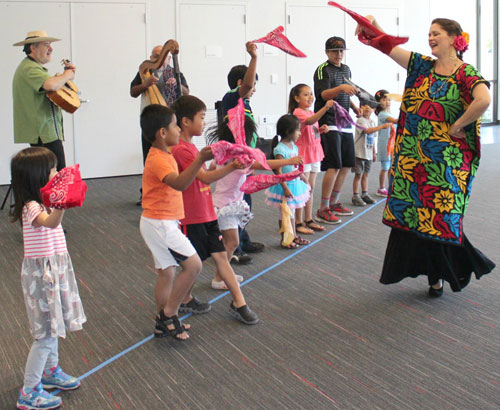
Salvador, Victor and Jose Luis are mariachi musicians. Performing in front of the Northside Library at its Cinco De Mayo celebration on May 2, the men’s jovial music and harmonious voices reached library goers and passerbys.
“I want people to be more aware of cultural diversity and having this Cinco De Mayo festival may expose people to a new language and music,” says Cheryl Lee, branch manager and program coordinator of Northside Library.
Festive music is a big part of celebrating Cinco De Mayo. The mariachi performers’ songs included “Cielito Lindo,” about a beautiful lady in the countryside who has a birthmark next to her lip, and “Mariachi Loco,” known as a crazy and fun number to dance to. Two guitars and one requinto were played. The requinto is the lead guitar and is tuned two-and-a-half octaves higher than a regular guitar.
“The mariachi suits we wear show the difference between a charro, who is a person who rides horses, and a mariachi musician,” says Mario Hernandez, owner of Trio Sol de Mexico. “The musician wears the pants with all the buttons along the side. They’re very colorful. Their shirts all have embroidery. The bowtie is another ornament, like a pearl necklace on a lady.”
When the mariachi performance ended, Cascada de Flores put on a musical theater show in the community room with performers Arwen Lawrence, Jorge Liceaga and Maestro Artemio Posadas.
“We are showing a story about traditional Mexican dance music,” says Lawrence. “Out of songs come characters like the tecolote, which is the owl, and there’s also the zopilote, the vulture, and the old man. The title of the show is ‘The Tree and the Donkey Who Love to Sing.’ We learn how the instruments [that create traditional Mexican folk music] come from the wood of the tree.”
Instruments featured included strings, such as the vihuela, harp, requinto jarocho, jarana jarocha, violin and percussion, like the donkey jaw and tarima. The show was bilingual and interactive, so attendees occasionally practiced Spanish phrases, such as “por favor” and “buenos tardes.”
Children also had opportunities to take the stage, on one occasion performing a dance with handkerchiefs as Lawrence led them.
Liceaga explained that his green shirt is called a guayabera. Lawrence’s traditional dress displaying colorful birds, leaves and flowers is called a huipil.
“We want to educate, entertain and empower people to learn more about Mexico,” Liceaga says.
